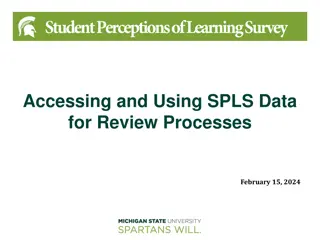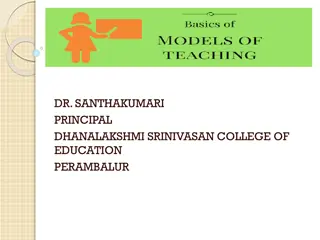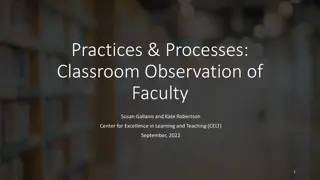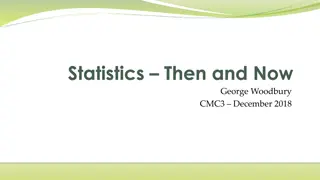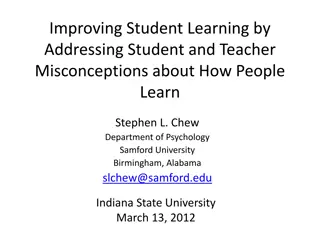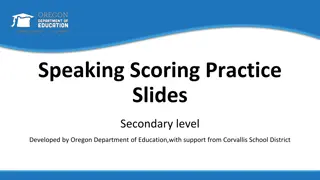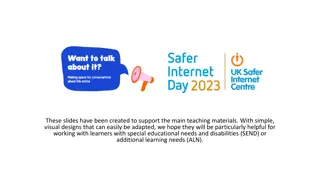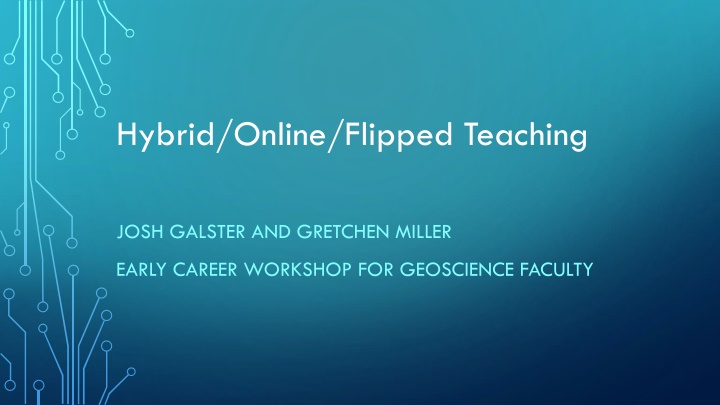
Effective Strategies for Hybrid, Online, and Flipped Teaching in Geoscience Faculty Workshops
Explore the challenges and benefits of online teaching, methods to enhance your online class, transition materials between online and in-person settings, communication strategies, active learning ideas, and assessment techniques. Learn from experienced faculty about their reflections and experiences over the past two years, and discover both the challenges and benefits of online teaching and learning. Gain insights into considerations and strategies for effective online teaching, emphasizing continuity of learning outcomes and student engagement.
Download Presentation

Please find below an Image/Link to download the presentation.
The content on the website is provided AS IS for your information and personal use only. It may not be sold, licensed, or shared on other websites without obtaining consent from the author. If you encounter any issues during the download, it is possible that the publisher has removed the file from their server.
You are allowed to download the files provided on this website for personal or commercial use, subject to the condition that they are used lawfully. All files are the property of their respective owners.
The content on the website is provided AS IS for your information and personal use only. It may not be sold, licensed, or shared on other websites without obtaining consent from the author.
E N D
Presentation Transcript
Hybrid/Online/Flipped Teaching JOSH GALSTER AND GRETCHEN MILLER EARLY CAREER WORKSHOP FOR GEOSCIENCE FACULTY
Definitions Synchronous learning live activities with instructor and all students Asynchronous learning activities completed on students own time Flipped class asynchronous lectures, active learning during in-person class Hybrid class blend of online and face-to-face teaching and learning
Session Goals Identify the challenges and benefits of online teaching Reflect on methods to more fully develop your online class AND/OR transition teaching materials between online and in-person environments Consider some communication and management strategies for your class Share ideas for active learning and assessment in an online environment Use online experiences to benefit future teaching plans
Our Experiences Over the Past 2 Years Josh: Almost entirely online first year, both asynchronous and synchronous, somewhat by choice. Used more flipped and hybrid components this year, in addition to traditional in-person. Gretchen: All asynchronous online first year of pandemic, without the lab kits I was used to having for my online classes. During second year taught a mix of online, hybrid, and in-person classes - really enjoyed teaching in a variety of ways again! Your experience/reflections on online teaching?
Some Challenges of Online Teaching and Learning Preparation and management time Creative strategies for teaching, engagement, and assessment Structuring class and communicating expectations to students Managing communication Student buy-in
Some Benefits of Online Teaching and Learning Flexibility and convenience Accessibility Opportunities created by formalized asynchronous learning Higher enrollment and student satisfaction Resources developed for online classes may enhance in-person classes
Considerations and Strategies Key considerations: 1. Effective online teaching must include the same learning outcomes and expectations as an in-person class (use backwards design). 2. Online teaching does NOT reduce your contact time with students, it just moves it from face-to-face to an online environment. 3. Consistency and clear communication are essential for student success in an online environment.
Considerations and Strategies Use a variety of teaching techniques to engage students Recognize the differences between in-person and online teaching Include active learning and formative assessment in an online environment Manage asynchronous and synchronous learning activities Create a fully accessible course
Reflection/Table Discussions Use your experience of online teaching/learning to help you plan for the upcoming year: What resources can you use again? How can your resources be modified to fit different learning environments? What additional resources do you need? Lessons learned for moving forward?
Communication Plan Should be clearly described in the syllabus Reiterate the plan early and implement it consistently Include protocols for synchronous and asynchronous activities Communication plan should answer the following questions: How should students contact you? When and how can students expect a response to their inquiries? What type of feedback will students receive? How will announcements/reminders be communicated? How will you facilitate student-student interactions?
Include a Map to Success (example announcement from Gretchen s Introductory Geology online class)
Management Plan Strategies for handling online interactions with and among students Set clear expectations for how inappropriate communication will be handled Synchronous communication etiquette is similar to a classroom Asynchronous communication management issues can arise Strategies for dealing with some communication problems Inactivity give students credit for participation/asynchronous feedback Dominant student(s) start early with step up or step back Digressions set clear expectations and provide feedback frequently Shared misconceptions allow students to self-assess and correct their work Inappropriate comments set expectations for etiquette and respect
Assessments and Beyond Use a variety of assessments, both formative and summative Image interpretation Strongly recommend AGAINST using high-stakes at-home tests Encourages cheating Grading scheme could be designed with student input at beginning of class Some activities transfer easily between in-person and online Online vs. In-Person proctoring solutions Many resources available online https://nagt.org/nagt/profdev/webinars/suddenly_online/index.html#resources
Active learning and formative assessment Discussion board example from Gretchen s Introductory Geology online class: Students help each other complete weekly lecture and lab assignments (similar to group work for in- person classes), points earned for both asking and answering questions Two attempts allowed for each weekly assignment to improve learning and incentivize participation
Technology Examples Slack: Group communications, file sharing, announcements Piazza: Course bulletin board, allows students to answer each other s questions Zoom, Microsoft Teams, Blackboard Ultra: Live presentations, virtual office hours Camtasia: Recording lectures and demonstrations SoftChalk:Used to create interactive online lessons Others? *Always keep in mind privacy and accessibility!
Technology Examples Open Educational Resources (OER) Many examples included with OER presentation during Concurrent Sessions 1 Padlet Interactive post-its that students can use to respond to prompts Google Docs Good for collaborative work, and it s possible to track student contributions YouTube Many good videos available, also easily share your own videos with students


